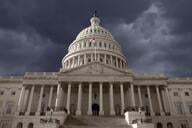You have /5 articles left.
Sign up for a free account or log in.
Riding my bike last fall, I started thinking about momentum. In physics, momentum is “the product of the mass and velocity of an object,” and the greater that product, the more force is needed to stop the object. That certainly applies to my bike when I try to surmount hills by beginning them at high speed, but does the term also apply to students trying to finish their college degrees?
Perhaps it is not students’ momentum but their growing vision of the top of the hill -- the approaching sight of graduation day -- that energizes them to attain their goals. Perhaps we should consider motivating students by focusing on what they have left to do, as opposed to, or in addition to, what they have already done for graduation. Perhaps we should focus on making learning more efficient, so that graduation day arrives more quickly.
At least since 1999, when Clifford Adelman published his groundbreaking monograph Answers in the Tool Box: Academic Intensity, Attendance Patterns and Bachelor’s Degree Attainment, the term “momentum” has been used to describe the increased probability of students finishing their college degrees that accompanies credit accumulation. More specifically, Adelman found that students were likely to finish their degrees -- their graduation trajectory was harder to interrupt -- if they accumulated at least 20 credits in their first year of college.
Since Adelman’s 1999 monograph, numerous publications have used the concept of academic momentum and similar concepts to help explain why students do or do not finish their degrees and to suggest ways in which we can help them to do so. An especially insightful paper is one by Paul Attewell, Scott Heil and Liza Reisel entitled “What Is Academic Momentum? And Does It Matter?” It shows that data confirm the central claims of momentum theory. For example, Attewell, Heil and Reisel found that the number of courses attempted by students in their first college semester predicts the rate at which students cumulate credits over subsequent years. Also consistent with momentum theory is the more general finding that the more credits accumulated, the more likely is graduation. (It was knowledge of this principle that once led a college’s chief operating officer to tell me that the way to increase that college’s unsatisfactory graduation rate was obviously to admit only students who had accumulated a great many credits.)
Concepts similar to academic momentum have been used to help understand the likelihood of attaining a wide variety of goals. One paper used a chemistry, instead of a physics, analogy in stating that cumulated credits “catalyze” progress to degree (catalysis is “the increase in the rate of a chemical reaction due to the participation of an additional substance”). In the psychology research literature, the concept of momentum has been useful in describing such behaviors as competing in sports and task completion.
Although momentum-like concepts have been useful in explaining college students’ and others’ goal-related behavior, the variable of accumulated credits, which predicts college graduation, may be correlated with a different variable. And it is therefore also possible that that latter variable is as useful, or even more useful, in understanding how to help students graduate.
More specifically, note that if it takes 120 credits to finish a degree, saying you are more likely to finish that degree if you have accumulated at least 20 credits in your first year of college is mathematically equivalent to saying that you are more likely to finish that degree if, at the end of that first year, you have at most 100 credits left to earn. Perhaps it is focusing on what credits are left to earn, not the credits that have already been accumulated, that is most useful in promoting degree completion. Perhaps it is the pull exerted by a shorter period of time to graduation, rather than the push exerted by more cumulated credits, that most increases the likelihood of degree receipt.
In what follows I discuss those possibilities and their implications. Is the evidence consistent with the hypothesis that the time to the reward (or desired outcome or goal) of degree completion influences degree completion? What are some ways that we could better help students finish their degrees if that hypothesis turns out to be correct?
What the Research Tells Us
First let’s consider as a whole the body of work examining the effect of reward delay on behavior. For many decades, experiments have shown that reward delay has a strong effect on behavior. (See my book Self-Control: Waiting Until Tomorrow for What You Want Today.) Animals of all sorts -- including humans -- tend to choose an immediate reward over a delayed reward. When hungry, we prefer to eat now, not tomorrow, and the gaming industry knows what it is doing when it has our slot machine winnings immediately pour out into our hands instead of being delivered via a check that comes weeks later in the mail. We work harder to obtain less delayed, as opposed to more delayed, rewards, and we choose less delayed over more delayed rewards. A reward’s delay affects our motivation for that reward -- our tendency to do things to attain that reward as opposed to doing something else.
Research has also shown that when the reward delay is relatively short, small changes in the delay can have a big effect on obtaining that reward. But when the reward delay is long, small changes in the delay have relatively little effect on obtaining that reward. If such findings apply to credits and graduation, you would expect to see an accelerating probability of graduation as the remaining needed credits decrease. The evidence described above in which the probability of graduation increases as total cumulated credits increase is consistent with such a relationship. However, whether the rate at which the probability of graduation increases changes as reward delay decreases remains to be explored, and would be a useful research project.
More generally, the concept of motivation (someone’s tendency to choose to behave in a specific way) can help us understand what contributes to academic success. Being sufficiently motivated to engage in certain specific actions, not just the ability to learn new things, can be crucial to how well a student does in college. For example, students accepted to college need to actually start college, the opposite of the phenomenon known as summer melt. As another example, remedial courses can be no help to students if they do not enroll in them or finish them, and many students do not.
In fact, evidence suggests that students faced with a particularly time-consuming remedial intervention (which implies a particularly long delay to graduation), are less likely to even attend college. Further, coming to class (independent of what is done there) is a strong predictor of whether a student will pass the class, but unfortunately many students choose to be places other than their classrooms. Many students also suffer insurmountable financial difficulties in completing college because they do not complete, or even start, the FAFSA. And a common explanation for why high school grades, as opposed to one-shot tests, better predict college performance is that grades provide a better measure of students’ ability to stick to academic tasks over the long haul.
In other words, college grades, as opposed to tests, provide a better measure of the critical variable of motivation. The currently popular concept of grit, thought by many to be critical in academic success, is essentially a measure of motivation as it relates to delayed large rewards. The Wikipedia definition for grit is “a positive, noncognitive trait based on an individual's passion for a particular long-term goal or end state, coupled with a powerful motivation to achieve their respective objective.”
Motivating Students to Succeed
For all of those reasons, the concept of motivation seems a useful approach to understanding how to help college students succeed and graduate, and reward delay seems to be a vital determinant of students’ motivation. As summarized by William Bowen and Michael McPherson in their insightful new book, Lesson Plan: An Agenda for Change in American Higher Education, “It is highly likely that the prospect of long time to degree deters some students from ever starting -- never mind finishing -- their degree programs, and thus contributes directly to low overall levels of educational attainment.”
Focusing on decreasing the delay to graduation instead of on credit accumulation is consistent with the success of some specific interventions in increasing college student success. Two examples are the City University of New York’s ASAP (Accelerated Study in Associate Programs) and CUNY Start programs. Both require academic progress by students that is more rapid than usual. ASAP does so by requiring all students to attend full time. CUNY Start requires its students, all of whom have multiple remedial needs, to attend remedial classes 25 hours per week, with a goal of completing all remedial course work within one semester. Both programs emphasize decreasing the time to degree. A rigorous randomized controlled trial has shown ASAP to approximately double associate-degree graduation rates, and quasi-experimental data have also shown CUNY Start to be effective (a randomized controlled trial is in progress).
More generally, research has shown that developmental education that is compressed (e.g., taught in shorter terms), accelerated (e.g., skips lower-level courses and provides tutoring instead) and streamlined (eliminates unnecessary topics) -- all of which should decrease the perceived time to graduation -- is effective in increasing progress toward graduation. The positive effects on graduation of college credits earned from Advanced Placement and high school dual enrollment courses are also consistent with the concept that decreasing the delay to graduation is useful in increasing behaviors that result in graduation. Further, identifying and requiring students to follow clear paths to graduation, which should increase students’ perceived efficiency of time needed to receive a degree, has been found to be effective in increasing graduation rates, as discussed at length in Thomas Bailey, Shanna Jaggars and Davis Jenkins’s well-received book, Redesigning America’s Community Colleges: A Clearer Path to Student Success. (Note that it’s perceived efficiency and perceived reward delay that will affect students’ behavior, not actual efficiency or delay.)
It isn’t actually clear precisely why decreasing delay to graduation (or to any goal or reward) would increase the probability of graduation. Less time to graduation may increase the frequency of behaviors such as studying that are essential to graduating, an example of the increased pull from a less-delayed reward mentioned above. Alternatively, or in addition, receipt of the reward may become more likely as reward delay decreases because there is a shorter period of time during which other events can interfere with receiving the reward.
More time to graduation also provides more opportunities for a student’s close relative to become ill, for a student’s car to require unaffordable repairs and for someone to offer a student a low-paying but immediately available full-time job. As stated by Complete College America, “Time is the enemy of college completion … The longer it takes, the more life gets in the way of success.”
Those two possible mechanisms -- more proximate rewards increasing behaviors likely to obtain the rewards, and more proximate rewards decreasing the opportunities for outside events to interfere with reward attainment -- may be related. You may not be motivated to work for a reward that you are unlikely to get. In one experiment, experienced provosts were more likely to choose a smaller, more immediate amount of money for their units as opposed to a larger, more delayed amount of money, possibly because they had learned that their units were unlikely ever to receive future promised money.
For our purposes right now, the essential, overall point is simply that decreasing the delay of a reward is more likely to increase the receipt of the reward. However, exploration of the mechanisms responsible for any such effects -- whether people are more motivated by less delayed rewards and/or whether outside events are less likely to interfere with receipt of less delayed rewards -- should prove useful in the future.
Strategies That May Help
Psychology research provides general guidance about how to help someone engage in the behaviors needed to attain a delayed goal. Evidence-based strategies include reminding the person of the delayed goal (again see my book Self-Control: Waiting Until Tomorrow for What You Want Today), monitoring progress to the goal frequently, reporting or making public that monitoring and physically recording the results of that monitoring. Consistent with those recommendations, when I’m on my bike, if a hill looks high above me and far away, I estimate the number of seconds to reach the top, then look directly down at the ground (so that the incline is not so apparent) and count the number of seconds that I pedal, impressing upon myself how quickly the number of seconds left to the top is decreasing.
More specifically with regard to degree attainment, if reward delay is important in motivating students to complete their degrees, then a useful strategy might be to help students frame their progress in terms of what is left rather than what has already been completed. For example, perhaps class status (freshman, sophomore, junior, senior) should be defined by how many credits are left for the degree rather than by how many credits have been accumulated, as is usually done.
Reminders about the goal of graduation, and having students repeatedly monitor the credits remaining for their degrees, may also be useful. We need to help students think about how much they have left to do and not just how much they have completed. Further, without in any way sacrificing learning quality, we need to do everything possible to help what is left to be done take as short a time as possible -- and to be perceived by students as taking as short a time as possible. And we need to continue to conduct research about the best ways to do all of this. The current six-year bachelor’s degree national graduation rate of only 59 percent is not acceptable.
Time -- how long something takes, how much time has passed and how much time is left --- can be a useful way to organize and make use of the evidence about what does and does not increase graduation rates. Academic momentum measured as cumulated credits may have been a useful concept for increasing college success, but it is time for us to also consider using delay to graduation as a factor that influences whether students graduate. The top of the hill may not actually pull my bike up, but thinking that the top isn’t far away sure helps me keep pedaling.




